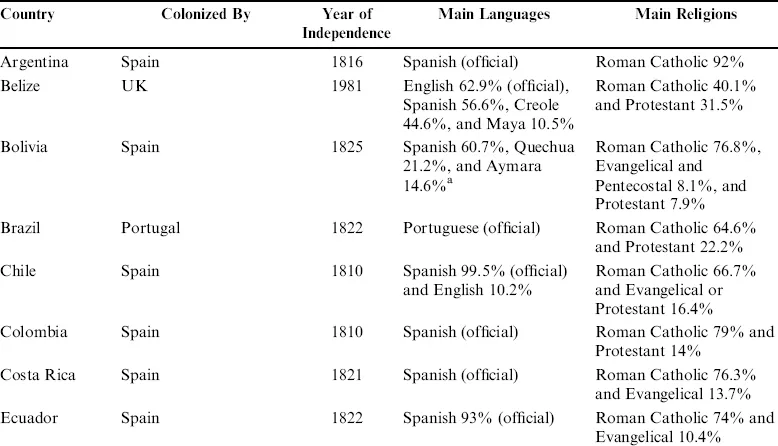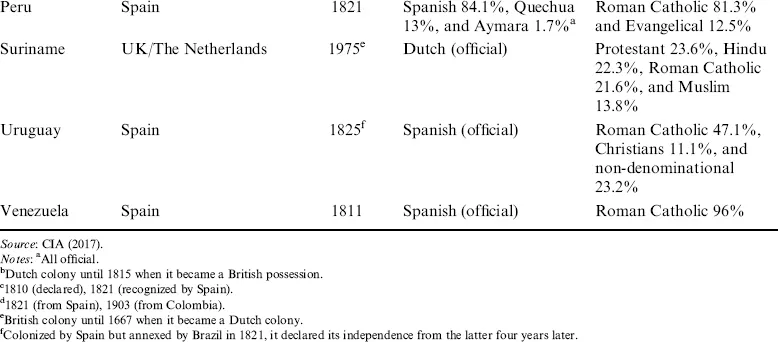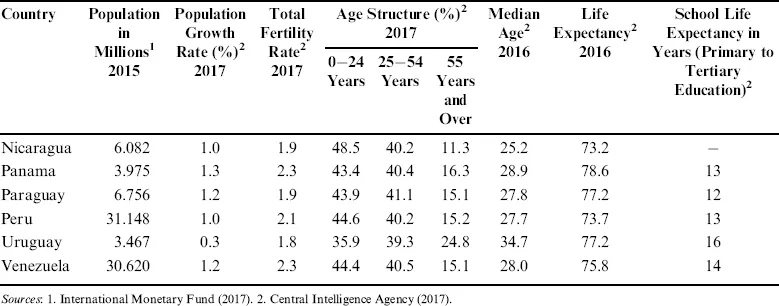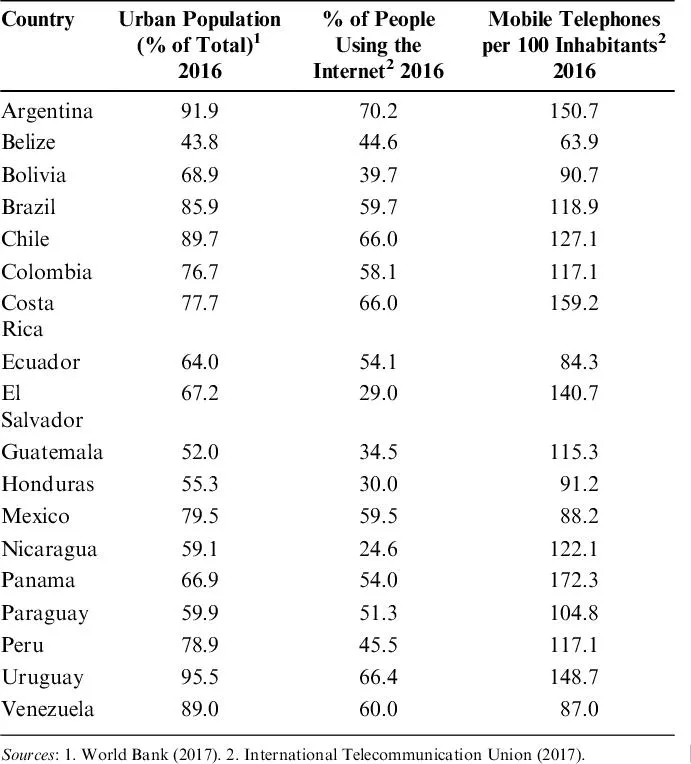![]()
Chapter 1
Latin America: Countries with a Common Past Facing Different Realities
The evolution and the major challenges facing management education in Latin America are strongly related to its history, culture, and economic development. This chapter provides a brief introduction to, and overview of, the main historical, cultural, social, political, and economic aspects characterizing the Latin American region.
The term Latin America is generally used to refer to all countries in the Americas south of the US where the Spanish or Portuguese languages are dominant, and which were Spanish or Portuguese colonies in the past.
By this definition, Latin America is equivalent to “Ibero-America,” where the prefix Ibero relates to the Iberian Peninsula in Europe. Another important term to be aware of is Hispanic America, which comprises Spanish-speaking countries in the Americas. Hispanic America differs from Ibero-America in that the latter includes Hispanic America and Brazil and sometimes the Iberian Peninsula as well.
However, for the purpose of this book, the analysis will focus on the countries of the Latin America mainland.
This book offers a detailed examination of the common cultural elements of Latin America, particularly its colonial history; its demographic structure and social development; its legal and regulatory framework; its main governance concerns; its economic growth and the extent of international trade and global connections; and its distinctive management profile.
These elements are analyzed using data from various international organizations such as the International Monetary Fund, the World Bank, the International Communication Union, and Transparency International. Some data were also gathered from the US Central Intelligence Agency (CIA).
Common Historical and Cultural Aspects among Latin American Countries
Mainland Latin America is regarded as being composed of 20 countries and one dependent territory. Geographically, it can be divided into three sub-regions: North America (Mexico), Central America, and South America.
Central America is bordered by Mexico to the north, Colombia to the southeast, the Caribbean Sea to the east, and the Pacific Ocean to the west. It comprises seven countries: Belize, Guatemala, Honduras, El Salvador, Nicaragua, Costa Rica, and Panama, which together represent almost 8% of the population in the region (IMF, 2017).
South America is bounded by Panama to the northwest, the Caribbean Sea to the north, the Atlantic Ocean to the northeast, east, and southeast, and the Pacific Ocean to the west. It has more than 70% of the total population of mainland Latin America (IMF, 2017) and consists of 12 countries: Argentina, Bolivia, Brazil, Chile, Colombia, Ecuador, Guyana, Paraguay, Peru, Suriname, Uruguay, and Venezuela, and French Guiana, a French dependency.
The Latin America region shares a common history of colonial rule, mainly Spanish, which lasted three centuries. As Table 1.1 shows, 16 of the 20 countries on the Latin American mainland were Spanish colonies from the late fifteenth century till the end of the eighteenth century and gained independence between 1810 and 1825.
Table 1.1. Colonization and Main Languages and Religions in Latin America.
Of the four remaining countries, Brazil was colonized by the Portuguese and became independent in 1822 while Belize officially became a colony of British Honduras in 1854 and its independence was delayed until 1981 due to territorial disputes between the UK and Guatemala.
Guyana, originally a Dutch colony in the seventeenth century, became a British territory in 1815 and achieved independence from the UK in 1966. Suriname was initially explored by the Spaniards in the sixteenth century, colonized by the UK in the mid-seventeenth century and later became a Dutch colony in 1667, gaining its independence from the Netherlands in 1975.
The shared experience of colonization by the Spaniards among most Latin American countries exposed them to two critical cultural aspects: their language and religion, as shown in Table 1.1.
Spanish is the official language of most nations on the Latin America mainland and is spoken as a first language by more than 60% of the population. Portuguese is uniquely spoken in Brazil, the largest and most populous Latin American country with over 35% of the aggregate population in the region. English is the official language of Belize and Guyana while Dutch is the official language in Suriname. About 5% of the population speaks other European or native languages.
Since the Spaniards were committed to converting natives to Christianity, this became the dominant religion in the region. Indeed, the Latin American mainland has the largest concentration of Roman Catholics in the world (Holy See Press Office, 2016). In the case of Central America, Roman Catholicism was the most popular religion in the region until the 1960s, since when there has been an increase in other Christian groups, mainly Protestant.
Guyana and Suriname, former British and Dutch possessions, respectively (see above), followed a very different path than the rest of the countries on mainland Latin America and share more historical and cultural bonds with some Caribbean countries, not only in terms of language but also regarding religion. Their populations together accounts for less than 0.25% of the total population in the region, the vast majority descendants of African slaves and Indian and Javanese contract workers. As such, these countries are not necessarily considered part of Latin America and will be excluded from the rest of the analysis.
The Latin American People
Analyzing the human capital characteristics of the different countries of Latin America is crucial to understanding their existing and future development conditions as well as the present situation and future evolution of education, particularly management education, within them.
This section examines in detail demographic data including current population, annual growth rate, fertility rate, age structure, and life expectancy and school life expectancy. In all cases, a comparison with aggregate world figures and selected developed countries and emerging economies is offered.
The total population of mainland Latin America was estimated at more than 580 million people in 2015, which represents approximately 8% of the world population (IMF, 2017). The five most populous countries in the region, in descending order, are: Brazil, with more than 35% of the region's population, Mexico with nearly 21%; Colombia with about 8%; Argentina with almost 7.5%; and Peru with around 5%. This information and all demographic data are shown in Table 1.2.
Table 1.2. Main Demographic Indicators of Latin American Countries.
In 2017, the average population growth rate in the region was 1.1%, which is slightly below the world average but more than three times higher compared with the European Union (EU) and is also above the US and Indonesia (CIA, 2017; World Bank, 2017). The Latin American countries with the highest population growth rates are Belize, Guatemala, and Honduras, all located in Central America, followed by Bolivia in South America. These countries have also the highest total fertility rates and the youngest populations. The countries that are growing less are El Salvador and Uruguay.
As to the average total fertility rate in Latin America, it was estimated at 2.2 births per woman in 2017, comparable to Indonesia but again below the world average though more than 50% higher than Japan and nearly 40% above the EU, China, and Russia (CIA, 2017; World Bank, 2017). Brazil, Chile, and Uruguay have the lowest total fertility rate in the region with 1.8 children per woman, similar to the US.
In terms of age, Latin America has a rather young population compare it with developed countries such as Germany and Japan whose populations have a median age of 47 years (CIA, 2017). The median age in the region was about 28 years in 2016, similar to India. Uruguay, Chile, Brazil, and Argentina are countries with older populations (CIA, 2017).
It is interesting to note that the countries with the highest percentages of people within prime working age (25–54 years), the usual target market of graduate programs and executive education, are Costa Rica, Brazil, and Chile.
The average life expectancy at birth in Latin America in 2016 was 75 years, 3 years above the world average but 10 years below Japan and 5 years lower than countries such as Germany, the UK and the US (CIA, 2017; World Bank, 2017). The countries with higher life expectancy, which is an indicator of the overall quality of life in a country, are Chile, Costa Rica, and Panama while Belize and Bolivia have lower life expectancy at birth.
As regards to educational attainment, the mean years of school life expectancy in the region are 14, 4 years below the UK (CIA, 2017). Argentina, Chile, and Uruguay are the countries with higher school life expectancy, whereas two Central American countries, Guatemala and Honduras, have the lowest.
Table 1.3 summarizes the societal situation of Latin American countries associated with urbanization and technological development. In terms of the percentage of the total population living in urban areas, the average percentage in the region was 72% in 2016, which is well above the world average of 54% (World Bank, 2017).
Table 1.3. Urbanization and Technological Development in Latin America.
Again, Uruguay, Argentina, and Chile are the countries with higher values while Belize, Guatemala, and Honduras, all from Central America, have the lower percentages of urban populations.
The average percentage of individuals using the Internet in Latin America in 2016 was 51%, very close to the world average of 52% but nearly half of that in the UK, South Korea, Japan, and Germany (ITU, 2017). Once more, the countries with higher percentages are Argentina, Uruguay, Chile, and Costa Rica; lower penetration rates obtain in Central America, Nicaragua, El Salvador, Honduras, and Guatemala.
In 2016, Latin America comprised approximately 9% of the world’s mobile telephone subscribers and the average mobile telephone subscription per 100 inhabitants in the region was above the world average – 117 versus 109 (ITU, 2017). Panama, Costa Rica, and Argentina had the higher figures, and Belize and ...






